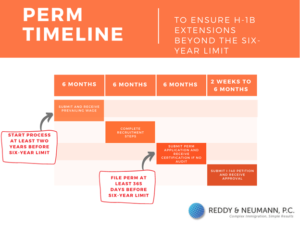
Ensuring H-1B Employees can Extend Beyond the Six-Year Limit
The H-1B visa is used by U.S. employers to temporarily employ foreign workers in a specialty occupation. It is typically used for professionals who have at least a bachelor’s degree in a specific field of study that is required by the occupation. H1-B visas are the most commonly used visa for employment-related entrance to the United States, and as a result, there are annual quotas that cap the number that are issued every year as well as a limit on the length of stay.
USCIS can approve H-1B petitions for an initial period of up to three years and can grant extensions for up to an additional three years. Under certain circumstances, USCIS may extend an H-1B worker’s employment authorization beyond the six-year limit.
The ability to extend beyond six years was provided for in the American Competitiveness in the Twenty-First Century Act of 2000, commonly referred to as AC-21. USCIS may grant a one-year extension of stay beyond the six-year limit under AC21 if:
- A PERM labor certification is unexpired at the time of filing of the H-1B extension petition; and
- The PERM labor certification was filed with DOL or the I-140 petition was filed with USCIS at least 365 days prior to the date the alien beneficiary will have exhausted 6 years of H-1B status in the United States.
A separate provision of AC-21 provides for a three-year extension of stay beyond the six-year limit if the H-1B worker is the beneficiary of an approved I—140 petition, but cannot adjust status to lawful permanent resident due to unavailability of immigrant visa numbers. Previously, PERM labor certification processing times and the availability of premium processing for I-140 petitions often meant that an H-1B employee could be sponsored for PERM labor certification in his or her sixth year of H-1B status and receive an I-140 approval in time to qualify for this three-year extension.
However, increased processing times related to the PERM labor certification have made this practically impossible. The PERM process should typically be started early enough to ensure that both the PERM and I-140 petition can be approved before the employee’s H-1B status maxes out. But, due to the possibility that these processes can be delayed by audits or Requests for Evidence as well as the potential for premium processing to be suspended by USCIS at any time, the best practice is to start the process early enough to ensure that the PERM labor certification is filed at least 365 days before the six-year max-out date. This way, if the PERM approval is delayed due to an audit, or the I-140 petition approval is delayed due to a Request for Evidence of lack of premium processing, the employee will still qualify for a one-year extension of H-1B status.
Based on current processing times, employers should consider initiating the PERM process at least two years before the employee’s expected six-year limit will be reached. As shown above, this provides sufficient time for the prevailing wage determination to be issued by the Department of Labor and the required recruitment steps to be completed so that the PERM can be filed 365 days before the six-year limit.
By: Emily Neumann
Emily Neumann is Managing Partner at Reddy Neumann Brown PC with 15 years of experience practicing US immigration law providing services to U.S. businesses and multinational corporations. Emily has been quoted in Bloomberg Law, U.S. News & World Report, Inside Higher Ed, and The Times of India on various hot topics in immigration. She is a member of the American Immigration Lawyers Association and Society for Human Resource Management.


